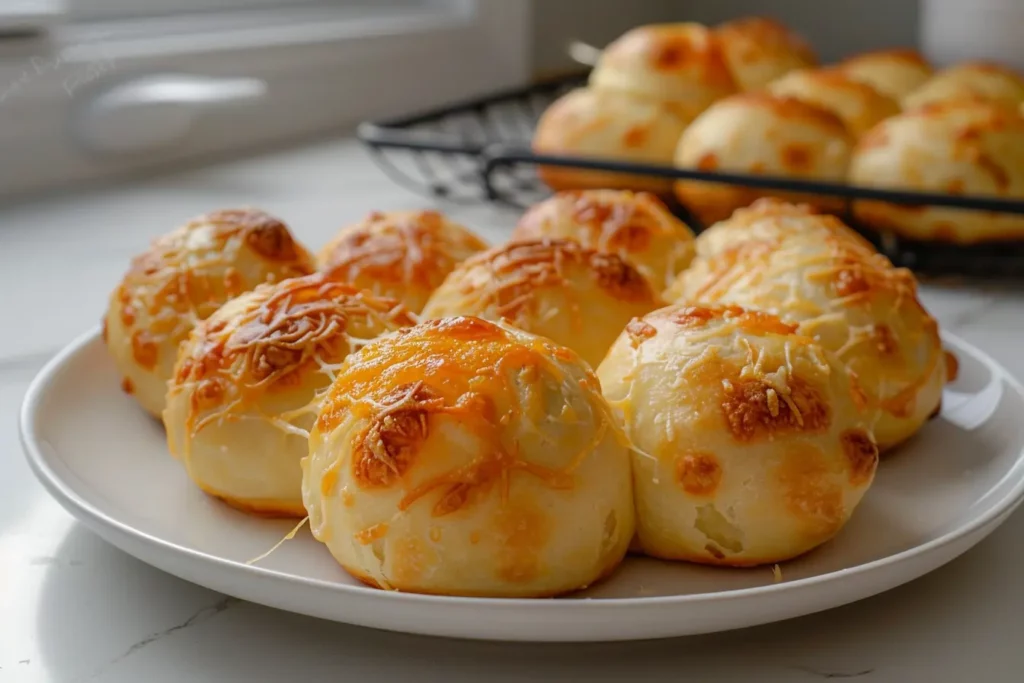Cheese Rolls are the kind of comfort snack that never goes out of style. Whether you’re craving something warm, gooey, and golden or looking for an easy appetizer for your next gathering, cheese rolls deliver every time. With a crisp exterior and melty cheese filling, they’re a guaranteed crowd-pleaser that works for both everyday snacks and special occasions.
The beauty of cheese rolls lies in their simplicity and versatility. From classic New Zealand-style versions to Lebanese variations, these cheesy bites come in many shapes and flavors. This article shows you exactly how to make them at home, what ingredients to use, how to get the perfect crisp, and what to serve them with—plus a few cultural surprises along the way.
What Are Cheese Rolls?
History and Origin of Cheese Rolls
Cheese rolls have become more than just a simple snack—they’re a global favorite with deep cultural roots. In New Zealand, cheese rolls are a regional classic known as “Southland sushi.” Created during the 1950s, they began as a creative way to turn basic ingredients—white bread, grated cheese, and evaporated milk—into something warm and filling. Toasted until golden and crisp, these rolls quickly earned their place in cafés, schools, and homes.
In contrast, Lebanese cheese rolls bring a Mediterranean twist. These are typically made using thin phyllo or spring roll wrappers filled with salty cheeses like feta or Akkawi. Sometimes flavored with fresh herbs, they’re rolled tightly and fried until crunchy. Though prepared differently, both variations showcase the universal appeal of wrapping cheese in dough for the ultimate bite.
Over time, cheese rolls spread beyond local borders and found their way into party platters, school lunches, and street food markets. Today, from Dunedin to Detroit, the cheesy crunch of these rolls continues to win hearts and appetites.
Why Cheese Rolls Are Popular Around the World
The success of cheese rolls lies in their irresistible texture and flavor. The contrast between a crispy outer shell and a melty cheese center makes them hard to resist. With minimal ingredients and fast prep time, cheese rolls are ideal for both quick weekday snacks and weekend gatherings.
Another reason they’ve gone global is versatility. You can bake or fry them, serve them hot or cold, and use countless cheese combinations. Whether you stick with cheddar or experiment with mozzarella, gouda, or even jalapeño jack, cheese rolls adapt to your kitchen and taste.
Cheese rolls also cross cultures effortlessly. They show up in European bakeries, Middle Eastern mezze trays, and American appetizer menus. Their simplicity makes them easy to learn, but their flavor keeps people coming back for more. It’s comfort food in its purest form—and that’s why cheese rolls are here to stay.
Ingredients Needed for Cheese Rolls

Core Ingredients for Basic Cheese Rolls
To make classic cheese rolls, you only need a few affordable pantry staples. This simplicity is one of the biggest reasons the recipe is so popular. At its core, the filling combines cheese, dairy, and seasonings to create a smooth, savory spread that melts beautifully inside bread or pastry.
Here’s a look at the standard ingredients for traditional cheese rolls:
| Ingredient | Purpose |
|---|---|
| White Bread | Flexible base that toasts well and holds filling |
| Cheddar Cheese | Sharp flavor and gooey melt factor |
| Evaporated Milk or Cream | Adds creaminess and binds the filling |
| Butter or Margarine | Used to toast or fry for that crispy golden finish |
| Onion Soup Mix or Mustard (optional) | Adds bold flavor and a tangy kick |
These ingredients come together quickly and make a batch of cheese rolls that can be baked or fried depending on your preference.
Optional Add-Ins for Flavor Twists
Once you’ve mastered the base, it’s easy to customize your cheese rolls with flavorful additions. Whether you’re looking for spice, freshness, or extra creaminess, there are countless combinations to try. For a savory twist, add garlic powder, diced jalapeños, or smoked paprika to your filling.
Fresh herbs like parsley or chives add color and a light aromatic note. Some cooks like to blend multiple cheeses, combining cheddar with mozzarella, pepper jack, or parmesan for extra depth.
For Mediterranean-style cheese rolls, try using crumbled feta and mint. Want something creamy and tangy? A spoonful of cream cheese or sour cream adds a rich layer. These flavor upgrades help your cheese rolls stand out without complicating the recipe.
Using different types of wrappers also changes the final taste. Traditional bread works well for New Zealand-style rolls, while phyllo dough or wonton wrappers make a crispier Lebanese-style bite.
To explore more bold cheese-based dishes, check out this Cajun Mac and Cheese or Cheesy Air Fryer Chicken Parmesan Wraps, both perfect complements to your kitchen’s cheese obsession.
How to Make Cheese Rolls Step-by-Step

Preparing the Filling and Rolling the Cheese Rolls
Making homemade cheese rolls is easy, fast, and satisfying. The secret lies in preparing a creamy, flavorful filling and rolling it correctly for even toasting or frying. Start by grating your cheese—cheddar is a favorite for its bold flavor and meltability. Mix it with a splash of evaporated milk or cream until it becomes thick but spreadable. You can also stir in optional flavor boosters like mustard, onion soup mix, or herbs.
Next, take your slices of white bread and trim off the crusts for a cleaner roll. Lightly flatten each slice with a rolling pin to make them easier to work with. Spread a thin layer of cheese filling on one side, then roll it up tightly like a cigar. A little butter on the outside helps them brown and crisp beautifully during cooking.
If you’re using phyllo or spring roll wrappers for a Lebanese-style version, place a spoonful of the cheese mixture on one end, fold in the sides, and roll. Seal the edges with water or egg wash to hold everything together. No matter your wrapper, the technique is simple but effective—and that’s why cheese rolls remain a go-to recipe in many kitchens.
Cooking Options: Frying vs Baking Cheese Rolls

There’s more than one way to cook cheese rolls, and your choice depends on the texture you want. Baking is a healthier option and gives the rolls a golden finish without extra oil. Simply place the rolled cheese bread on a lined baking sheet, brush the tops with melted butter, and bake at 375°F (190°C) for about 12–15 minutes, flipping halfway through for even browning.
For a crispier, indulgent finish, frying is a great choice. Heat oil in a skillet or deep fryer and cook each roll until it turns a rich golden brown—usually about 2–3 minutes per side. Be sure not to overcrowd the pan, and drain them on paper towels to remove excess oil.
If you’re short on time, air frying is a third option. Set your air fryer to 375°F, brush or spray the cheese rolls lightly with oil, and cook for 6–8 minutes, flipping once. The result is a satisfying crunch with less mess. Whichever method you choose, the goal is the same: crispy outside, melty cheese inside.
For another cheesy snack worth trying, check out these Air Fryer Potato Chips or this Cast Iron Skillet Pizza that delivers a similar crispy-cheesy combo.
Types of Cheese Rolls Around the World
New Zealand Cheese Scrolls Explained
In New Zealand, cheese scrolls are more than just food—they’re a regional tradition. Most commonly found in the South Island, these rolls are known as “Southland sushi,” a nickname earned for their rolled bread shape and snackable size. What makes them unique is the filling: a rich blend of grated cheese, evaporated milk, and dry onion soup mix. Spread onto thin slices of white sandwich bread, the mixture is rolled tightly and baked or grilled until crisp.
Locals often associate these cheese scrolls with fundraising events, school canteens, and casual café lunches. Their simplicity, affordability, and nostalgic value have helped them stay relevant for decades. Though similar in construction to pinwheels or grilled cheese sandwiches, the flavor and texture are unmistakably Kiwi.
They’re served hot and buttery, often with a hot cup of soup or tea. New Zealanders swear by their homemade versions, each family adding its twist—extra cheese, more spice, or even garlic butter brushed on top.
Looking for more comfort dishes like this? Try these Hello Dolly Bars for a sweet counterpart that’s just as simple and nostalgic.
Lebanese Cheese Pastries and How They Differ
Lebanese-style cheese pastries take a completely different approach, showing the dish’s global versatility. Instead of bread slices, these are made with thin wrappers—like phyllo, spring roll pastry, or even egg roll wrappers. The filling often includes a mix of white cheese like feta or Akkawi, seasoned with fresh herbs such as mint or parsley.
Once rolled tightly, they’re deep-fried until golden brown and crispy. The result is a flaky, savory bite packed with salty cheese and a refreshing herbal kick. These pastries are usually served as part of a mezze platter, alongside hummus, olives, and stuffed grape leaves. They’re also a hit at parties and holiday gatherings.
Unlike the New Zealand version, Lebanese cheese pastries focus on sharp, briny flavors and a crisp, delicate crunch. Both styles, though different in technique and taste, show just how flexible and beloved cheese-filled snacks have become worldwide.
To try another Mediterranean-inspired snack, check out this popular Baked Feta Cheese and Olives recipe—it pairs beautifully with crispy cheese pastries.
Cheese Rolling Tradition and Cultural Significance

What Is Cheese Rolling and Where It Came From
While cheese rolls are a beloved snack, the term “cheese rolling” refers to a completely different tradition—a thrilling, centuries-old sport held annually in Gloucestershire, England. The event involves rolling a large wheel of Double Gloucester cheese down a steep hill, while participants race after it at full speed, often tumbling the entire way. The first person to reach the bottom wins the cheese.
This chaotic yet wildly entertaining tradition draws thousands of spectators and participants each year. The origins of cheese rolling are unclear, but historians trace it back over 600 years. Some believe it began as a pagan ritual celebrating the arrival of spring and fertility. Over time, it evolved into the adrenaline-filled spectacle known today.
While it’s not directly related to edible cheese rolls, this quirky event has helped keep the concept of “cheese + fun” in the spotlight—reminding us how something as simple as cheese can become part of cultural identity and celebration.
For a savory dish that’s just as unforgettable as this wild event, you might want to try Braised Mexican-Style Beef Ribs—a bold main course that pairs wonderfully with cheesy sides.
Is Cheese Rolling British? History of the Tradition
Yes—cheese rolling is distinctly British and considered one of the UK’s most unusual yet beloved sports. Held on Cooper’s Hill near Brockworth, this event is a symbol of British eccentricity and rural tradition. Although it may look risky (and it definitely is), competitors return year after year for the thrill and the glory.
Despite attempts by local authorities to ban or regulate the event for safety reasons, the tradition continues unofficially—driven by community willpower and worldwide curiosity. It’s been featured in documentaries, news stories, and travel guides, drawing attention far beyond the UK.
Even though this tradition doesn’t involve cheese rolls in the culinary sense, both the event and the food share a common thread: cheese at the heart of memorable experiences. Whether you’re biting into a hot roll or watching daredevils tumble for cheese, it’s proof that this humble ingredient holds universal appeal.
If you’re curious about more globally inspired comfort food, check out this comforting Potato Tagine Recipe—a dish that’s just as rich in culture and flavor as cheese rolls.
Serving Suggestions for Cheese Rolls

Dips, Sauces, and Side Pairings for Cheese Rolls
Cheese rolls may be delicious on their own, but the right pairings can elevate them into a complete snack or meal. Whether you’re serving them as an appetizer, side dish, or party snack, the right dip makes all the difference. Popular choices include marinara sauce, ranch dressing, garlic aioli, or a tangy mustard dip.
If you’re leaning into Middle Eastern flavors with Lebanese-style cheese rolls, try serving them with hummus, tzatziki, or labneh topped with olive oil and za’atar. These creamy and tangy dips balance the richness of the melted cheese and crispy crust perfectly.
For gatherings or family dinners, cheese rolls also pair well with fresh salads, soups, or roasted vegetables. Tomato soup is a classic match, especially with toasted New Zealand-style cheese rolls. Looking for a cozy combination? Serve them alongside this Black-Eyed Pea Soup for a hearty and satisfying comfort meal.
If you’re in the mood for a brunch-style serving, cheese rolls go well with breakfast potatoes, scrambled eggs, or fresh fruit platters.
Best Beverages and Meals to Serve with Cheese Rolls
When it comes to drinks, the salty, cheesy goodness of cheese rolls goes hand-in-hand with refreshing options. Sparkling water with lemon, iced tea, or even a chilled glass of rosé wine complement the dish nicely. For kids, apple juice or milk are classic pairings.
Looking to turn cheese rolls into a full meal? Try combining them with a protein-rich salad or grilled meat. For instance, serving them alongside Grilled Tilapia with Tomato Avocado Salsa brings together crispy, creamy, and fresh elements in one dish.
For a vegetarian-friendly option, cheese rolls match well with Squash Croquettes, creating a crispy-on-crispy texture contrast that still feels light and wholesome.
These simple yet thoughtful pairings highlight the versatility of cheese rolls. Whether you’re going for bold flavors or subtle balance, there’s a perfect side or sip to go with every cheesy bite.
Storage, Reheating, and Meal Prep Tips

How to Store Cheese Rolls for Freshness
Leftover cheese rolls store well, which makes them an excellent choice for meal prep or batch cooking. To maintain their flavor and texture, let the rolls cool completely before storing them. If you place them in an airtight container while still warm, steam buildup can lead to sogginess.
Once cooled, store them in a single layer in an airtight container lined with paper towels. This helps absorb moisture and keeps the rolls crisp longer. You can refrigerate them for up to 4 days. For longer storage, freeze cheese rolls in a sealed freezer-safe bag. Place parchment paper between layers to prevent sticking.
Label your storage container with the date to keep track. When frozen properly, cheese rolls can last up to 2 months without losing quality.
For another freezer-friendly snack idea, try these No Bake Peanut Butter Cookies—they’re just as easy to prep and stash.
Reheating Tips for Perfect Texture
Reheating cheese rolls correctly helps you bring back that crispy exterior and gooey center. Avoid using the microwave, as it tends to make the rolls rubbery or soft. Instead, reheat them in the oven or air fryer for the best results.
Here are a few quick options:
- Oven Method: Preheat to 350°F (175°C). Place cheese rolls on a baking sheet and heat for 8–10 minutes until hot and crisp.
- Air Fryer: Set to 350°F. Heat for 4–5 minutes, flipping once halfway through.
- Skillet: Heat a nonstick pan over medium heat and toast the rolls until warmed through and lightly browned.
If reheating from frozen, let the rolls thaw in the fridge overnight for even heating. For fast results, the air fryer works great right from frozen—just add an extra minute or two.
Want more smart meal-prep sides? Pair cheese rolls with these Garlic Chive Mashed Potato Puffins—a great addition to any make-ahead meal plan.
Common Mistakes and Expert Tips for Best Cheese Rolls

Mistakes to Avoid When Making Cheese Rolls
Even though cheese rolls are simple to make, a few common mistakes can lead to soggy, bland, or uneven results. One of the biggest issues is using cheese that doesn’t melt well. Pre-shredded cheese often contains anti-caking agents that affect texture, so always grate fresh cheese for best meltability.
Another mistake is overfilling the bread or pastry. While it’s tempting to stuff the rolls with extra cheese, doing so can cause them to leak or split during baking or frying. Stick to a thin, even layer that spreads smoothly.
Skipping the crust-trimming step is another common misstep. Untrimmed bread tends to roll unevenly and may burn at the edges. Always flatten the bread before spreading the cheese mixture—it makes rolling tighter and more consistent.
Lastly, avoid cooking at too high a temperature. This can brown the outside before the filling heats through, leaving cold cheese inside. For evenly cooked cheese rolls, moderate heat is always best.
Chef Tips for Crispy, Golden, and Gooey Cheese Rolls
Want your cheese rolls to turn out perfectly every time? Follow these expert tips:
- Use a cheese blend: Mix sharp cheddar with mozzarella or gouda for a flavor-packed, extra melty filling.
- Add texture: Stir in chopped herbs, green onions, or finely diced jalapeños for depth and crunch.
- Butter the outside generously: Whether baking or frying, brushing butter or oil on the outer surface guarantees an even golden color and crisp texture.
- Seal edges well: For pastry-based rolls, use water or egg wash to keep everything inside during cooking.
- Serve immediately: Cheese rolls taste best hot and fresh. If making ahead, reheat using the oven or air fryer for best texture.
For more tips on building flavor and texture, check out this buttery Cornmeal Buttermilk Biscuits Recipe or these crispy Air Fryer Cinnamon Roll Tortillas for creative twists.
These final techniques make the difference between average and unforgettable cheese rolls—whether you’re cooking for guests or yourself.
FAQs About Cheese Rolls
What is in a cheese roll?
A classic cheese roll typically contains slices of white bread, grated cheddar cheese, and a creamy binding agent like evaporated milk or butter. Some recipes include flavor additions like mustard, onion soup mix, or herbs. The filling is spread over the bread, which is then rolled up and baked or fried. These simple ingredients give cheese rolls their signature crisp outside and melty, savory interior.
What are Lebanese cheese rolls?
Lebanese cheese rolls are made with phyllo or spring roll wrappers instead of bread. They’re filled with salty white cheeses like feta or Akkawi and often include fresh herbs like mint or parsley. The rolls are tightly wrapped and deep-fried until golden and crisp. Served hot, they’re a popular mezze dish and pair well with dips like labneh or hummus.
What are cheese rolls in New Zealand?
In New Zealand, cheese rolls are a regional favorite, especially in the South Island. Known as “Southland sushi,” they consist of white bread filled with a cheesy mixture made from grated cheese, evaporated milk, and sometimes onion soup mix. The bread is rolled up, buttered, and toasted until golden. These cheese rolls are often served with soup or as a café snack.
What is the meaning of cheese rolling?
Cheese rolling is not related to food but is instead a traditional British sport. Participants chase a large rolling wheel of cheese down a steep hill. The event, held in Gloucestershire, is chaotic and fast-paced, often leading to falls and tumbles. Though not connected to cheese rolls, this entertaining tradition keeps cheese culture alive in a very different way.
Is cheese rolling British?
Yes, cheese rolling is a British event with roots in Gloucestershire, England. It’s been celebrated for over 600 years, originally tied to seasonal festivals. Today, it’s a major tourist attraction known for its wild downhill races and high-energy atmosphere. Though it shares the word “cheese,” it has nothing to do with cooking or eating cheese rolls.
What to serve with cheese rolls?
Cheese rolls go well with a variety of dips and sides. Marinara, ranch, garlic aioli, and mustard-based sauces are popular dipping options. For sides, consider serving them with tomato soup, fresh salad, or roasted vegetables. They also pair well with protein-based dishes and refreshing drinks like iced tea or sparkling water.
Final thoughts
Cheese rolls are more than just a cheesy snack—they’re a versatile comfort food enjoyed across cultures. Whether you prefer the New Zealand-style version baked to golden perfection or the Lebanese-inspired rolls fried until crispy, cheese rolls offer endless possibilities. They’re easy to make, highly customizable, and fit into any meal or occasion.
By following the tips in this guide, from choosing the right ingredients to mastering storage and reheating, you’ll never settle for soggy or bland rolls again. Pair them with your favorite dips, match them with warm soups or crunchy sides, and enjoy a bite that’s satisfying every single time. With a bit of planning and a good recipe, cheese rolls can go from casual snack to star of the table.
For more creative baking inspiration and marketing ideas, explore the Facebook and Pinterest.



